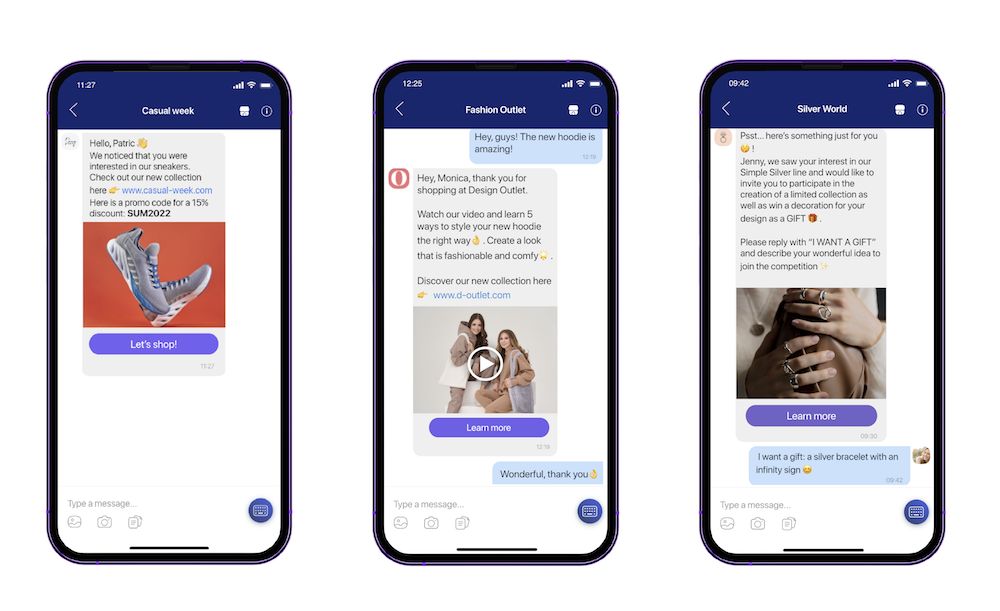Customer service, shopping, entertainment, and even payments are now being made through messaging apps. And there are no signs of slowing down as messaging apps bring more opportunities to use rich media and enhance customer experience every day. More and more people are turning to messengers to communicate with friends, family, and colleagues. Subsequently, messaging is already a significant driving force in brand communication as marketers connect with customers where customers are.
The first message that was sent via the precursor of the modern internet in 1969, was ‘LO’. It was American student Charley Kilne’s unsuccessful attempt to transmit “login” to a computer. Since then instant messaging has evolved significantly and messaging services have become increasingly popular as a way for people to connect. Recent studies show that we spend on average 2.5 hours on messaging apps daily. The same studies also found that the younger generation, 16-24-year-olds, spends nearly 3 hours on messaging apps every day.
There are many reasons for the traction of messaging apps. To name a few:
- The convenience of having a conversation anywhere and at any time.
- The ability to send multimedia messages, such as videos, images, and different types of files that can be more engaging and informative than text.
- Being less intrusive and giving the option to communicate via calls or messages.
Today, businesses adjust how they engage with consumers and switch from a distant, corporate communication style to a more personalized, friendly one. For example, 77% of businesses that started messaging clients during the pandemic plan to continue doing so. Modern-day customers respond much better to simple, genuine conversations from business accounts in messaging apps. These trends mean that this year adding messaging apps to the marketing toolkit has become a necessity for businesses—not just a discussion for some time in the future.
Here are a few marketing trends to watch in messaging apps in 2023:
More personalized messaging
As messaging becomes increasingly popular, and brands are increasingly adopting first-party data strategy, we’ll see more customization with content explicitly designed for customers or audience segments according to their interests and preferences. Connecting a CDP or a CRM for personalization is a norm in 2023, and allows taking your campaign performance to the next level.

Greater (and more creative) use of rich media content
Rich media, like videos and images, will continue to be used in messaging as they offer a highly engaging experience for users. At the same time, you can create a coherent vision of you as a brand by using advanced features that messaging apps have to offer. Create a customized chatbot, use AR technologies, games, and other content with recognizable design elements that support your brand voice and image. These features allow you to immerse your audience into the atmosphere you’d like to create, thus prolonging and enhancing their involvement with your content.
Increased use of chatbots
With a major recent breakthrough in chatbot technology, chatbots will become much more commonplace in apps as businesses look for ways to automate their marketing and customer support. Based on Viber’s internal data, last year there were 12 billion messages exchanged in chatbots on the app globally, showcasing the popularity of automated conversations. So it is best to start now and be on the frontline of the new approach.
AI takes the wheel
AI will play a more prominent role in messaging apps as businesses look to use it for personalization and understanding user behavior.
Chatbots already use machine learning elements and develop in understanding more complex human language. We are still in the very early stages of the technology adoption and will continue seeing more use cases frequently throughout 2023.
Laser focus on customer service
Consumers expect immediate interaction, and businesses continue improving how they communicate with buyers. Providing excellent customer service through messaging apps is becoming increasingly popular. Brands will need to learn to resolve issues faster and with a higher success rate, always be a step ahead of their clients’ needs and desires, and be ready to engage in real-time conversations.

We have seen true growth among messaging platforms in the last decade. Some major companies quickly caught up to this shift in user behavior, and today it’s absolutely common to talk to brands through the means previously reserved for personal communication. 2023 will certainly bring more businesses to the messaging apps and will see further evolution of brand-user communication.
